RMIT TCHE2558: Educational Leadership and Management Assignment
VerifiedAdded on 2022/09/02
|10
|2714
|45
Essay
AI Summary
This essay delves into the realm of educational leadership and management, specifically within the context of early childhood education. The paper is divided into two key parts: a reflective review and an exploration of pedagogical leadership. The reflective review section emphasizes the importance of reflection in developing leadership skills, drawing on personal experiences in the IT sector and highlighting the significance of democratic and transformational leadership styles. The pedagogical leadership section examines the role of pedagogical leadership in early childhood education, discussing its strengths and weaknesses, and its relationship to curriculum development and distributed leadership. The essay also differentiates between leadership and management, emphasizing their interconnectedness and the need for both in achieving organizational success. Finally, the essay concludes by advocating for the development of early leadership skills, encompassing both managerial and leadership qualities, and the adoption of a transformational leadership approach to inspire employees and achieve remarkable results, aligning with the principles of the Early Years Learning Framework and the National Quality Standards.
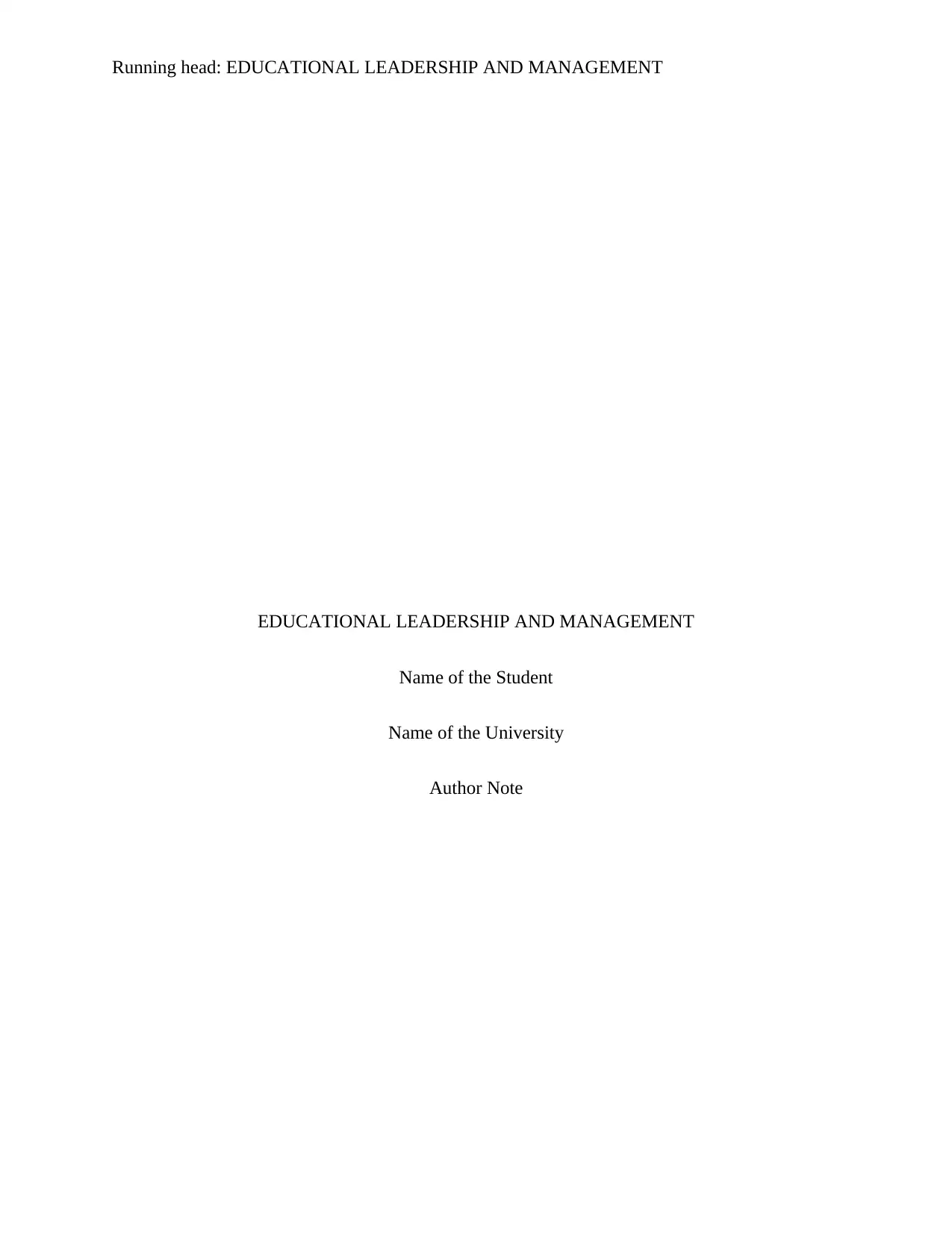
Running head: EDUCATIONAL LEADERSHIP AND MANAGEMENT
EDUCATIONAL LEADERSHIP AND MANAGEMENT
Name of the Student
Name of the University
Author Note
EDUCATIONAL LEADERSHIP AND MANAGEMENT
Name of the Student
Name of the University
Author Note
Paraphrase This Document
Need a fresh take? Get an instant paraphrase of this document with our AI Paraphraser
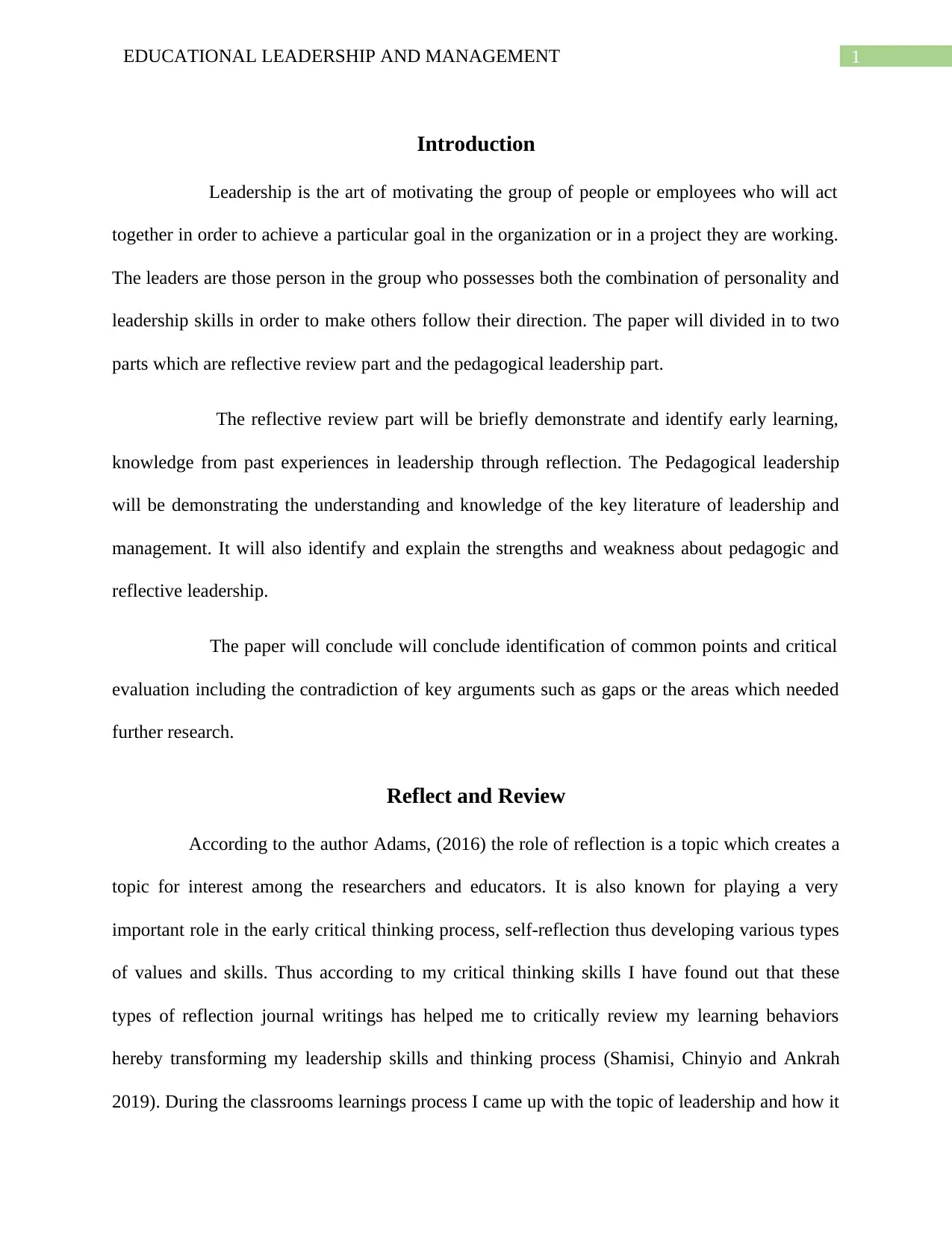
1EDUCATIONAL LEADERSHIP AND MANAGEMENT
Introduction
Leadership is the art of motivating the group of people or employees who will act
together in order to achieve a particular goal in the organization or in a project they are working.
The leaders are those person in the group who possesses both the combination of personality and
leadership skills in order to make others follow their direction. The paper will divided in to two
parts which are reflective review part and the pedagogical leadership part.
The reflective review part will be briefly demonstrate and identify early learning,
knowledge from past experiences in leadership through reflection. The Pedagogical leadership
will be demonstrating the understanding and knowledge of the key literature of leadership and
management. It will also identify and explain the strengths and weakness about pedagogic and
reflective leadership.
The paper will conclude will conclude identification of common points and critical
evaluation including the contradiction of key arguments such as gaps or the areas which needed
further research.
Reflect and Review
According to the author Adams, (2016) the role of reflection is a topic which creates a
topic for interest among the researchers and educators. It is also known for playing a very
important role in the early critical thinking process, self-reflection thus developing various types
of values and skills. Thus according to my critical thinking skills I have found out that these
types of reflection journal writings has helped me to critically review my learning behaviors
hereby transforming my leadership skills and thinking process (Shamisi, Chinyio and Ankrah
2019). During the classrooms learnings process I came up with the topic of leadership and how it
Introduction
Leadership is the art of motivating the group of people or employees who will act
together in order to achieve a particular goal in the organization or in a project they are working.
The leaders are those person in the group who possesses both the combination of personality and
leadership skills in order to make others follow their direction. The paper will divided in to two
parts which are reflective review part and the pedagogical leadership part.
The reflective review part will be briefly demonstrate and identify early learning,
knowledge from past experiences in leadership through reflection. The Pedagogical leadership
will be demonstrating the understanding and knowledge of the key literature of leadership and
management. It will also identify and explain the strengths and weakness about pedagogic and
reflective leadership.
The paper will conclude will conclude identification of common points and critical
evaluation including the contradiction of key arguments such as gaps or the areas which needed
further research.
Reflect and Review
According to the author Adams, (2016) the role of reflection is a topic which creates a
topic for interest among the researchers and educators. It is also known for playing a very
important role in the early critical thinking process, self-reflection thus developing various types
of values and skills. Thus according to my critical thinking skills I have found out that these
types of reflection journal writings has helped me to critically review my learning behaviors
hereby transforming my leadership skills and thinking process (Shamisi, Chinyio and Ankrah
2019). During the classrooms learnings process I came up with the topic of leadership and how it
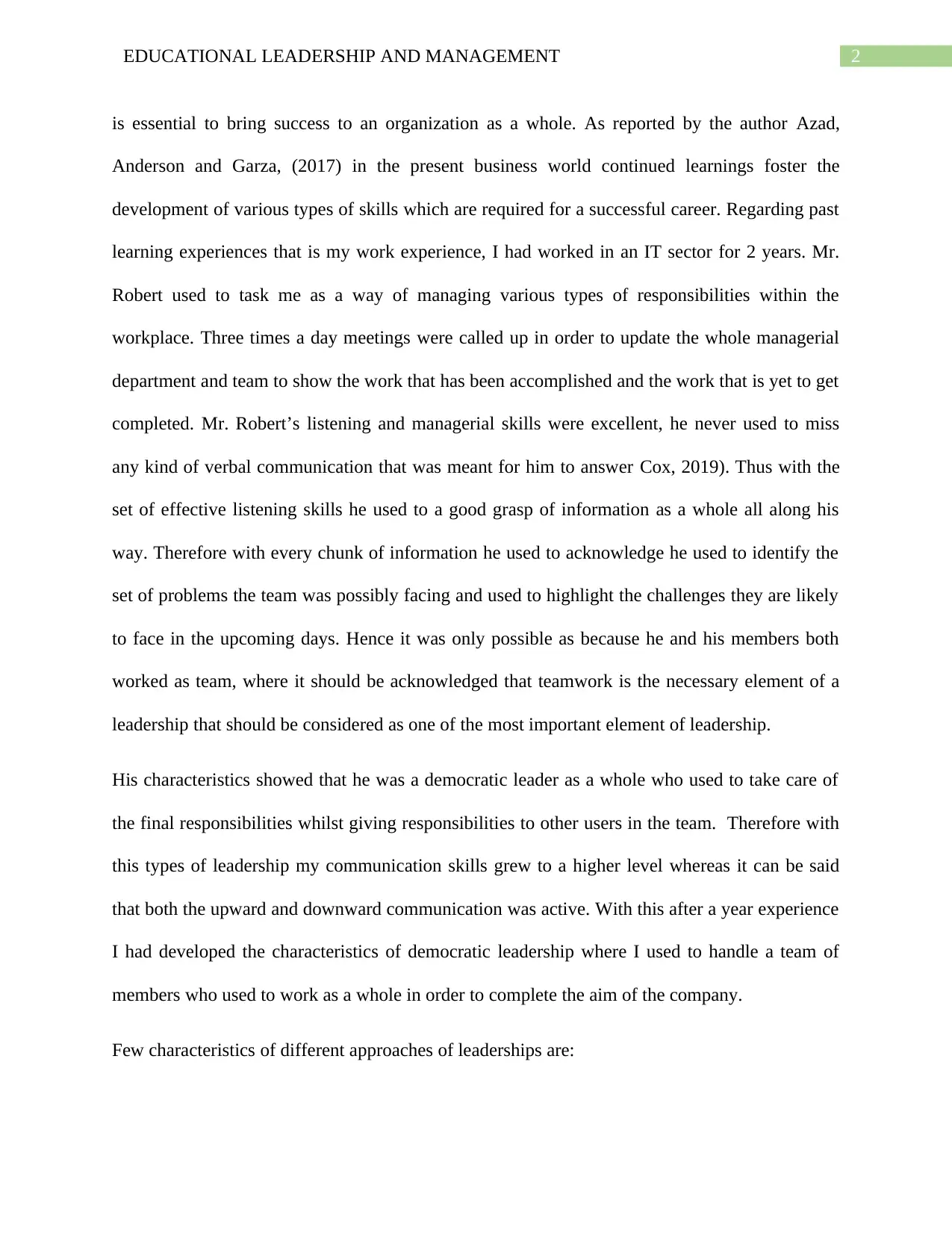
2EDUCATIONAL LEADERSHIP AND MANAGEMENT
is essential to bring success to an organization as a whole. As reported by the author Azad,
Anderson and Garza, (2017) in the present business world continued learnings foster the
development of various types of skills which are required for a successful career. Regarding past
learning experiences that is my work experience, I had worked in an IT sector for 2 years. Mr.
Robert used to task me as a way of managing various types of responsibilities within the
workplace. Three times a day meetings were called up in order to update the whole managerial
department and team to show the work that has been accomplished and the work that is yet to get
completed. Mr. Robert’s listening and managerial skills were excellent, he never used to miss
any kind of verbal communication that was meant for him to answer Cox, 2019). Thus with the
set of effective listening skills he used to a good grasp of information as a whole all along his
way. Therefore with every chunk of information he used to acknowledge he used to identify the
set of problems the team was possibly facing and used to highlight the challenges they are likely
to face in the upcoming days. Hence it was only possible as because he and his members both
worked as team, where it should be acknowledged that teamwork is the necessary element of a
leadership that should be considered as one of the most important element of leadership.
His characteristics showed that he was a democratic leader as a whole who used to take care of
the final responsibilities whilst giving responsibilities to other users in the team. Therefore with
this types of leadership my communication skills grew to a higher level whereas it can be said
that both the upward and downward communication was active. With this after a year experience
I had developed the characteristics of democratic leadership where I used to handle a team of
members who used to work as a whole in order to complete the aim of the company.
Few characteristics of different approaches of leaderships are:
is essential to bring success to an organization as a whole. As reported by the author Azad,
Anderson and Garza, (2017) in the present business world continued learnings foster the
development of various types of skills which are required for a successful career. Regarding past
learning experiences that is my work experience, I had worked in an IT sector for 2 years. Mr.
Robert used to task me as a way of managing various types of responsibilities within the
workplace. Three times a day meetings were called up in order to update the whole managerial
department and team to show the work that has been accomplished and the work that is yet to get
completed. Mr. Robert’s listening and managerial skills were excellent, he never used to miss
any kind of verbal communication that was meant for him to answer Cox, 2019). Thus with the
set of effective listening skills he used to a good grasp of information as a whole all along his
way. Therefore with every chunk of information he used to acknowledge he used to identify the
set of problems the team was possibly facing and used to highlight the challenges they are likely
to face in the upcoming days. Hence it was only possible as because he and his members both
worked as team, where it should be acknowledged that teamwork is the necessary element of a
leadership that should be considered as one of the most important element of leadership.
His characteristics showed that he was a democratic leader as a whole who used to take care of
the final responsibilities whilst giving responsibilities to other users in the team. Therefore with
this types of leadership my communication skills grew to a higher level whereas it can be said
that both the upward and downward communication was active. With this after a year experience
I had developed the characteristics of democratic leadership where I used to handle a team of
members who used to work as a whole in order to complete the aim of the company.
Few characteristics of different approaches of leaderships are:
⊘ This is a preview!⊘
Do you want full access?
Subscribe today to unlock all pages.

Trusted by 1+ million students worldwide
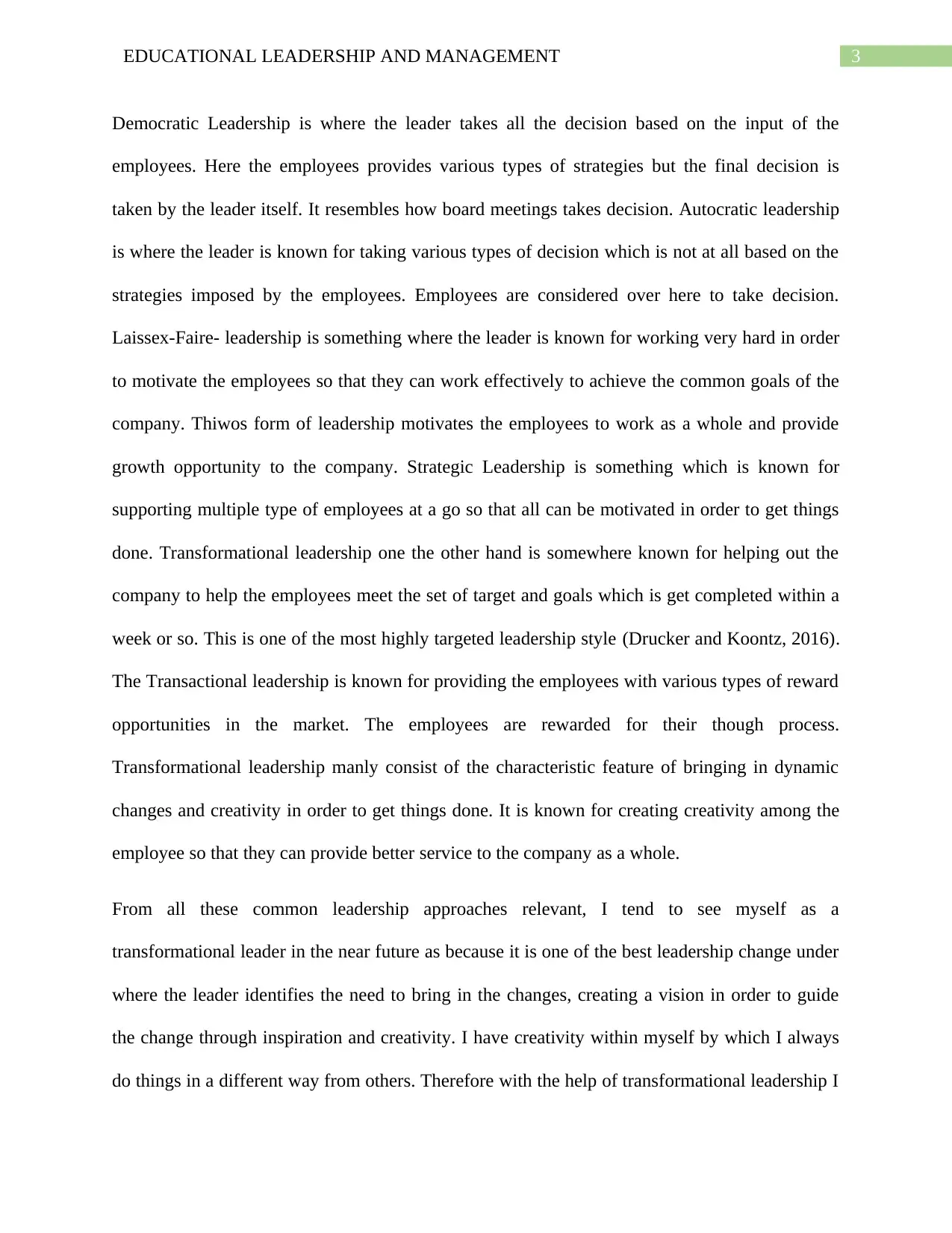
3EDUCATIONAL LEADERSHIP AND MANAGEMENT
Democratic Leadership is where the leader takes all the decision based on the input of the
employees. Here the employees provides various types of strategies but the final decision is
taken by the leader itself. It resembles how board meetings takes decision. Autocratic leadership
is where the leader is known for taking various types of decision which is not at all based on the
strategies imposed by the employees. Employees are considered over here to take decision.
Laissex-Faire- leadership is something where the leader is known for working very hard in order
to motivate the employees so that they can work effectively to achieve the common goals of the
company. Thiwos form of leadership motivates the employees to work as a whole and provide
growth opportunity to the company. Strategic Leadership is something which is known for
supporting multiple type of employees at a go so that all can be motivated in order to get things
done. Transformational leadership one the other hand is somewhere known for helping out the
company to help the employees meet the set of target and goals which is get completed within a
week or so. This is one of the most highly targeted leadership style (Drucker and Koontz, 2016).
The Transactional leadership is known for providing the employees with various types of reward
opportunities in the market. The employees are rewarded for their though process.
Transformational leadership manly consist of the characteristic feature of bringing in dynamic
changes and creativity in order to get things done. It is known for creating creativity among the
employee so that they can provide better service to the company as a whole.
From all these common leadership approaches relevant, I tend to see myself as a
transformational leader in the near future as because it is one of the best leadership change under
where the leader identifies the need to bring in the changes, creating a vision in order to guide
the change through inspiration and creativity. I have creativity within myself by which I always
do things in a different way from others. Therefore with the help of transformational leadership I
Democratic Leadership is where the leader takes all the decision based on the input of the
employees. Here the employees provides various types of strategies but the final decision is
taken by the leader itself. It resembles how board meetings takes decision. Autocratic leadership
is where the leader is known for taking various types of decision which is not at all based on the
strategies imposed by the employees. Employees are considered over here to take decision.
Laissex-Faire- leadership is something where the leader is known for working very hard in order
to motivate the employees so that they can work effectively to achieve the common goals of the
company. Thiwos form of leadership motivates the employees to work as a whole and provide
growth opportunity to the company. Strategic Leadership is something which is known for
supporting multiple type of employees at a go so that all can be motivated in order to get things
done. Transformational leadership one the other hand is somewhere known for helping out the
company to help the employees meet the set of target and goals which is get completed within a
week or so. This is one of the most highly targeted leadership style (Drucker and Koontz, 2016).
The Transactional leadership is known for providing the employees with various types of reward
opportunities in the market. The employees are rewarded for their though process.
Transformational leadership manly consist of the characteristic feature of bringing in dynamic
changes and creativity in order to get things done. It is known for creating creativity among the
employee so that they can provide better service to the company as a whole.
From all these common leadership approaches relevant, I tend to see myself as a
transformational leader in the near future as because it is one of the best leadership change under
where the leader identifies the need to bring in the changes, creating a vision in order to guide
the change through inspiration and creativity. I have creativity within myself by which I always
do things in a different way from others. Therefore with the help of transformational leadership I
Paraphrase This Document
Need a fresh take? Get an instant paraphrase of this document with our AI Paraphraser
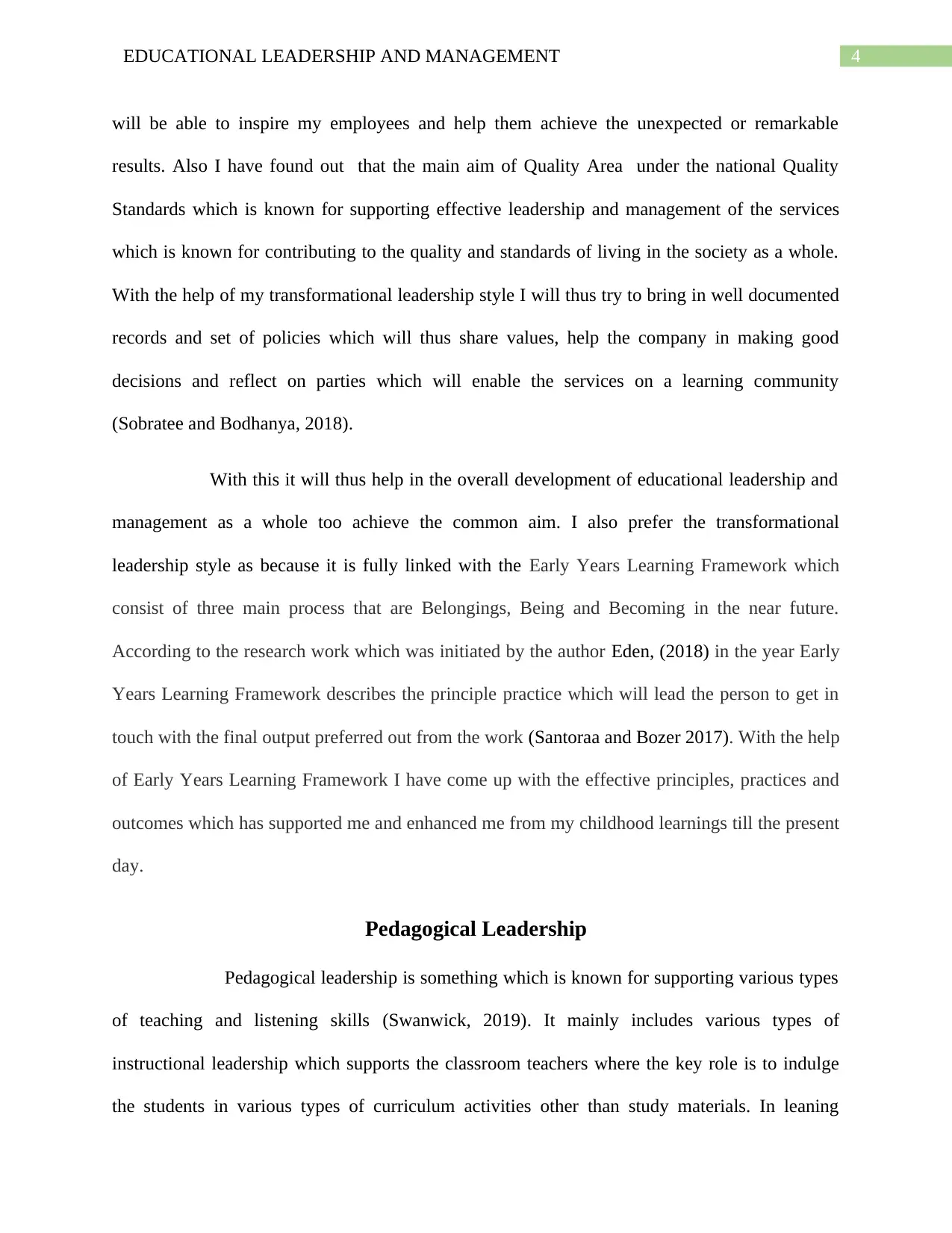
4EDUCATIONAL LEADERSHIP AND MANAGEMENT
will be able to inspire my employees and help them achieve the unexpected or remarkable
results. Also I have found out that the main aim of Quality Area under the national Quality
Standards which is known for supporting effective leadership and management of the services
which is known for contributing to the quality and standards of living in the society as a whole.
With the help of my transformational leadership style I will thus try to bring in well documented
records and set of policies which will thus share values, help the company in making good
decisions and reflect on parties which will enable the services on a learning community
(Sobratee and Bodhanya, 2018).
With this it will thus help in the overall development of educational leadership and
management as a whole too achieve the common aim. I also prefer the transformational
leadership style as because it is fully linked with the Early Years Learning Framework which
consist of three main process that are Belongings, Being and Becoming in the near future.
According to the research work which was initiated by the author Eden, (2018) in the year Early
Years Learning Framework describes the principle practice which will lead the person to get in
touch with the final output preferred out from the work (Santoraa and Bozer 2017). With the help
of Early Years Learning Framework I have come up with the effective principles, practices and
outcomes which has supported me and enhanced me from my childhood learnings till the present
day.
Pedagogical Leadership
Pedagogical leadership is something which is known for supporting various types
of teaching and listening skills (Swanwick, 2019). It mainly includes various types of
instructional leadership which supports the classroom teachers where the key role is to indulge
the students in various types of curriculum activities other than study materials. In leaning
will be able to inspire my employees and help them achieve the unexpected or remarkable
results. Also I have found out that the main aim of Quality Area under the national Quality
Standards which is known for supporting effective leadership and management of the services
which is known for contributing to the quality and standards of living in the society as a whole.
With the help of my transformational leadership style I will thus try to bring in well documented
records and set of policies which will thus share values, help the company in making good
decisions and reflect on parties which will enable the services on a learning community
(Sobratee and Bodhanya, 2018).
With this it will thus help in the overall development of educational leadership and
management as a whole too achieve the common aim. I also prefer the transformational
leadership style as because it is fully linked with the Early Years Learning Framework which
consist of three main process that are Belongings, Being and Becoming in the near future.
According to the research work which was initiated by the author Eden, (2018) in the year Early
Years Learning Framework describes the principle practice which will lead the person to get in
touch with the final output preferred out from the work (Santoraa and Bozer 2017). With the help
of Early Years Learning Framework I have come up with the effective principles, practices and
outcomes which has supported me and enhanced me from my childhood learnings till the present
day.
Pedagogical Leadership
Pedagogical leadership is something which is known for supporting various types
of teaching and listening skills (Swanwick, 2019). It mainly includes various types of
instructional leadership which supports the classroom teachers where the key role is to indulge
the students in various types of curriculum activities other than study materials. In leaning
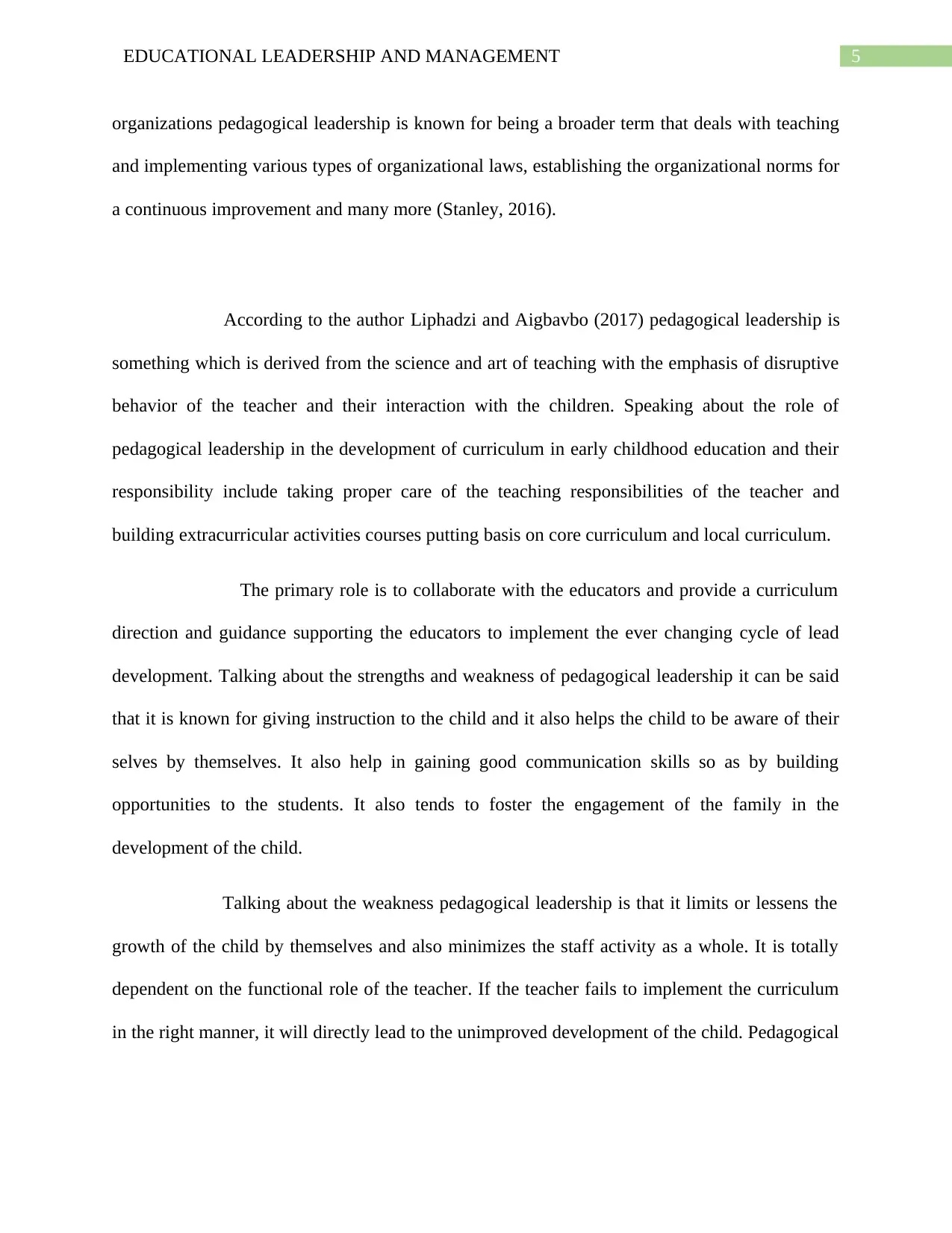
5EDUCATIONAL LEADERSHIP AND MANAGEMENT
organizations pedagogical leadership is known for being a broader term that deals with teaching
and implementing various types of organizational laws, establishing the organizational norms for
a continuous improvement and many more (Stanley, 2016).
According to the author Liphadzi and Aigbavbo (2017) pedagogical leadership is
something which is derived from the science and art of teaching with the emphasis of disruptive
behavior of the teacher and their interaction with the children. Speaking about the role of
pedagogical leadership in the development of curriculum in early childhood education and their
responsibility include taking proper care of the teaching responsibilities of the teacher and
building extracurricular activities courses putting basis on core curriculum and local curriculum.
The primary role is to collaborate with the educators and provide a curriculum
direction and guidance supporting the educators to implement the ever changing cycle of lead
development. Talking about the strengths and weakness of pedagogical leadership it can be said
that it is known for giving instruction to the child and it also helps the child to be aware of their
selves by themselves. It also help in gaining good communication skills so as by building
opportunities to the students. It also tends to foster the engagement of the family in the
development of the child.
Talking about the weakness pedagogical leadership is that it limits or lessens the
growth of the child by themselves and also minimizes the staff activity as a whole. It is totally
dependent on the functional role of the teacher. If the teacher fails to implement the curriculum
in the right manner, it will directly lead to the unimproved development of the child. Pedagogical
organizations pedagogical leadership is known for being a broader term that deals with teaching
and implementing various types of organizational laws, establishing the organizational norms for
a continuous improvement and many more (Stanley, 2016).
According to the author Liphadzi and Aigbavbo (2017) pedagogical leadership is
something which is derived from the science and art of teaching with the emphasis of disruptive
behavior of the teacher and their interaction with the children. Speaking about the role of
pedagogical leadership in the development of curriculum in early childhood education and their
responsibility include taking proper care of the teaching responsibilities of the teacher and
building extracurricular activities courses putting basis on core curriculum and local curriculum.
The primary role is to collaborate with the educators and provide a curriculum
direction and guidance supporting the educators to implement the ever changing cycle of lead
development. Talking about the strengths and weakness of pedagogical leadership it can be said
that it is known for giving instruction to the child and it also helps the child to be aware of their
selves by themselves. It also help in gaining good communication skills so as by building
opportunities to the students. It also tends to foster the engagement of the family in the
development of the child.
Talking about the weakness pedagogical leadership is that it limits or lessens the
growth of the child by themselves and also minimizes the staff activity as a whole. It is totally
dependent on the functional role of the teacher. If the teacher fails to implement the curriculum
in the right manner, it will directly lead to the unimproved development of the child. Pedagogical
⊘ This is a preview!⊘
Do you want full access?
Subscribe today to unlock all pages.

Trusted by 1+ million students worldwide
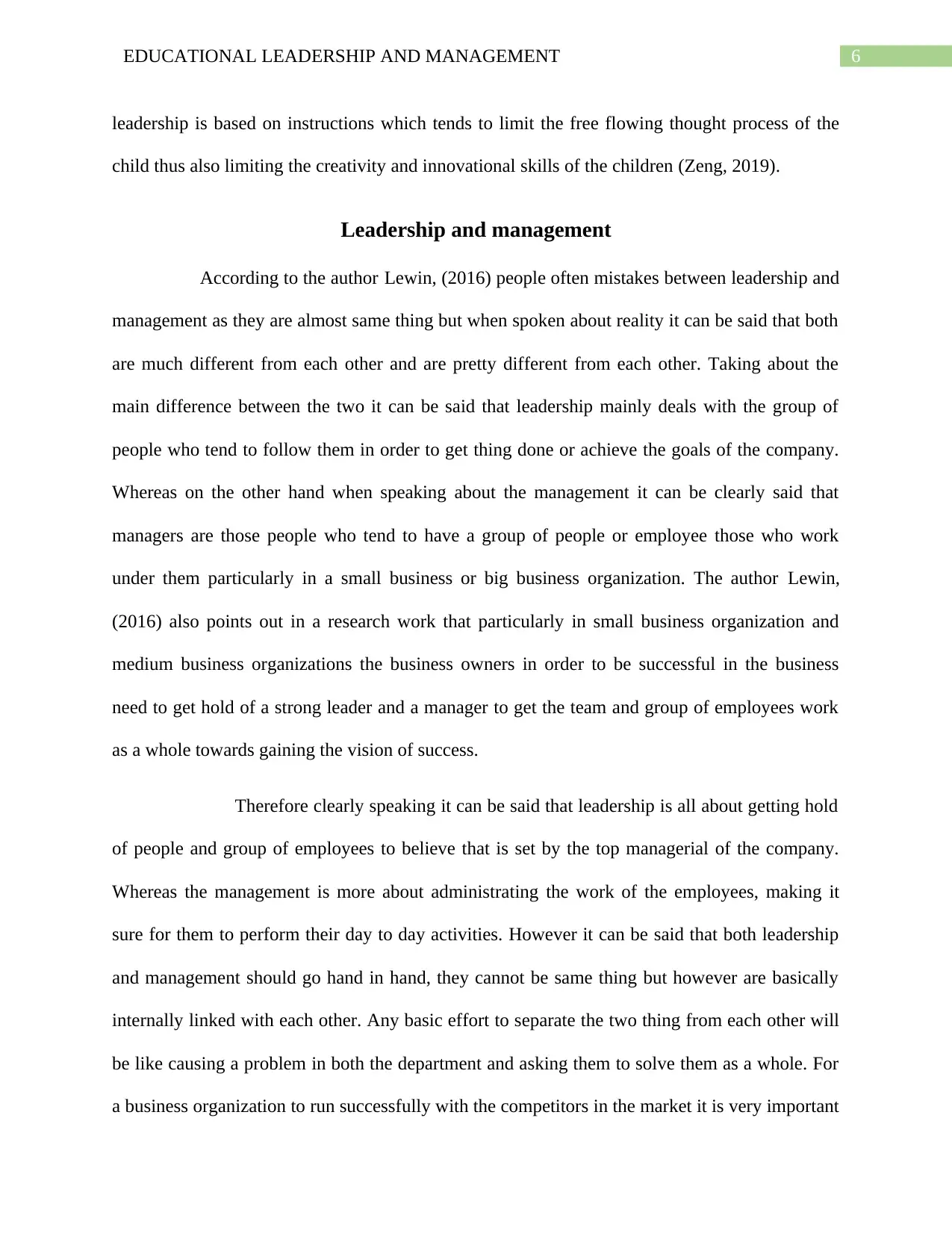
6EDUCATIONAL LEADERSHIP AND MANAGEMENT
leadership is based on instructions which tends to limit the free flowing thought process of the
child thus also limiting the creativity and innovational skills of the children (Zeng, 2019).
Leadership and management
According to the author Lewin, (2016) people often mistakes between leadership and
management as they are almost same thing but when spoken about reality it can be said that both
are much different from each other and are pretty different from each other. Taking about the
main difference between the two it can be said that leadership mainly deals with the group of
people who tend to follow them in order to get thing done or achieve the goals of the company.
Whereas on the other hand when speaking about the management it can be clearly said that
managers are those people who tend to have a group of people or employee those who work
under them particularly in a small business or big business organization. The author Lewin,
(2016) also points out in a research work that particularly in small business organization and
medium business organizations the business owners in order to be successful in the business
need to get hold of a strong leader and a manager to get the team and group of employees work
as a whole towards gaining the vision of success.
Therefore clearly speaking it can be said that leadership is all about getting hold
of people and group of employees to believe that is set by the top managerial of the company.
Whereas the management is more about administrating the work of the employees, making it
sure for them to perform their day to day activities. However it can be said that both leadership
and management should go hand in hand, they cannot be same thing but however are basically
internally linked with each other. Any basic effort to separate the two thing from each other will
be like causing a problem in both the department and asking them to solve them as a whole. For
a business organization to run successfully with the competitors in the market it is very important
leadership is based on instructions which tends to limit the free flowing thought process of the
child thus also limiting the creativity and innovational skills of the children (Zeng, 2019).
Leadership and management
According to the author Lewin, (2016) people often mistakes between leadership and
management as they are almost same thing but when spoken about reality it can be said that both
are much different from each other and are pretty different from each other. Taking about the
main difference between the two it can be said that leadership mainly deals with the group of
people who tend to follow them in order to get thing done or achieve the goals of the company.
Whereas on the other hand when speaking about the management it can be clearly said that
managers are those people who tend to have a group of people or employee those who work
under them particularly in a small business or big business organization. The author Lewin,
(2016) also points out in a research work that particularly in small business organization and
medium business organizations the business owners in order to be successful in the business
need to get hold of a strong leader and a manager to get the team and group of employees work
as a whole towards gaining the vision of success.
Therefore clearly speaking it can be said that leadership is all about getting hold
of people and group of employees to believe that is set by the top managerial of the company.
Whereas the management is more about administrating the work of the employees, making it
sure for them to perform their day to day activities. However it can be said that both leadership
and management should go hand in hand, they cannot be same thing but however are basically
internally linked with each other. Any basic effort to separate the two thing from each other will
be like causing a problem in both the department and asking them to solve them as a whole. For
a business organization to run successfully with the competitors in the market it is very important
Paraphrase This Document
Need a fresh take? Get an instant paraphrase of this document with our AI Paraphraser
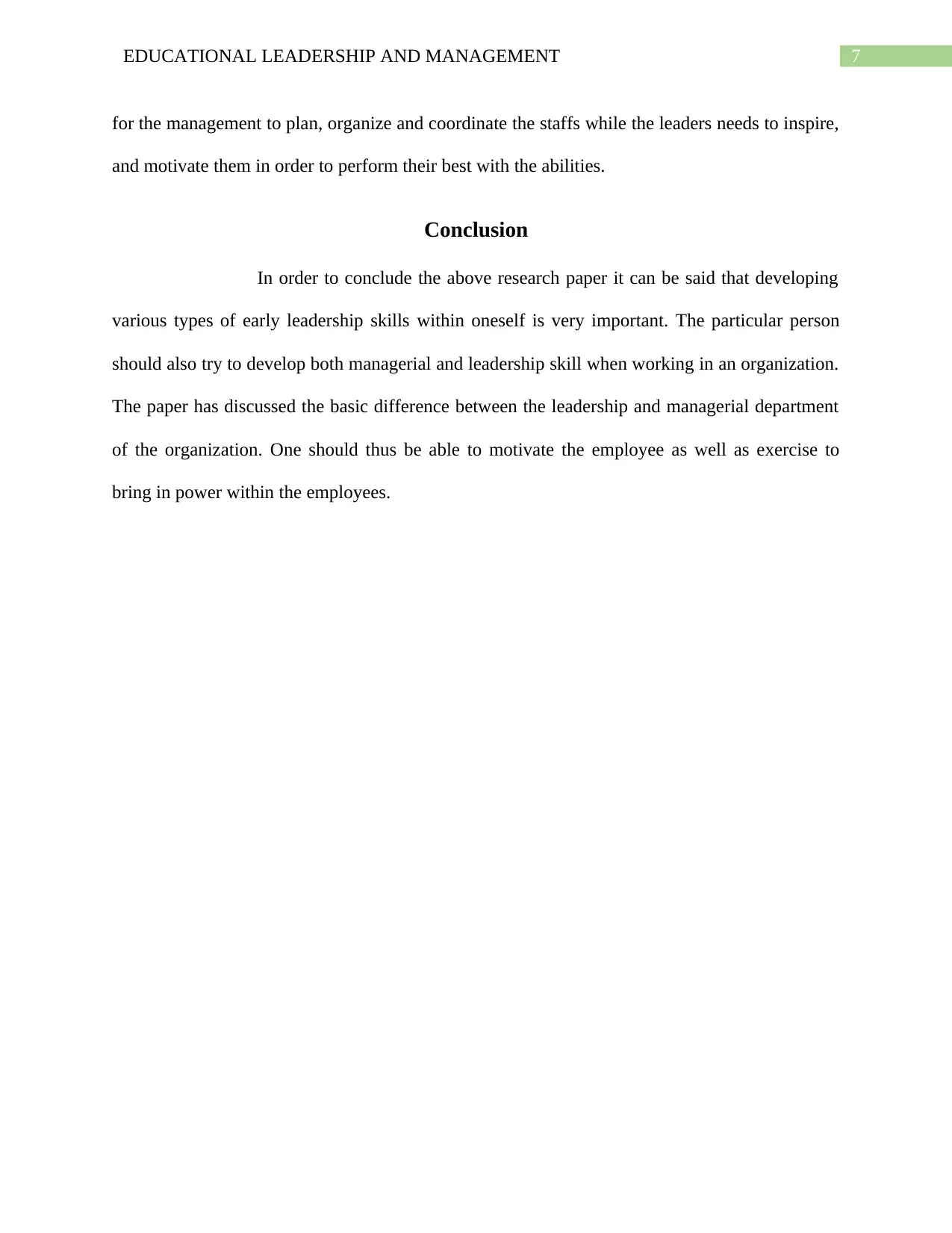
7EDUCATIONAL LEADERSHIP AND MANAGEMENT
for the management to plan, organize and coordinate the staffs while the leaders needs to inspire,
and motivate them in order to perform their best with the abilities.
Conclusion
In order to conclude the above research paper it can be said that developing
various types of early leadership skills within oneself is very important. The particular person
should also try to develop both managerial and leadership skill when working in an organization.
The paper has discussed the basic difference between the leadership and managerial department
of the organization. One should thus be able to motivate the employee as well as exercise to
bring in power within the employees.
for the management to plan, organize and coordinate the staffs while the leaders needs to inspire,
and motivate them in order to perform their best with the abilities.
Conclusion
In order to conclude the above research paper it can be said that developing
various types of early leadership skills within oneself is very important. The particular person
should also try to develop both managerial and leadership skill when working in an organization.
The paper has discussed the basic difference between the leadership and managerial department
of the organization. One should thus be able to motivate the employee as well as exercise to
bring in power within the employees.
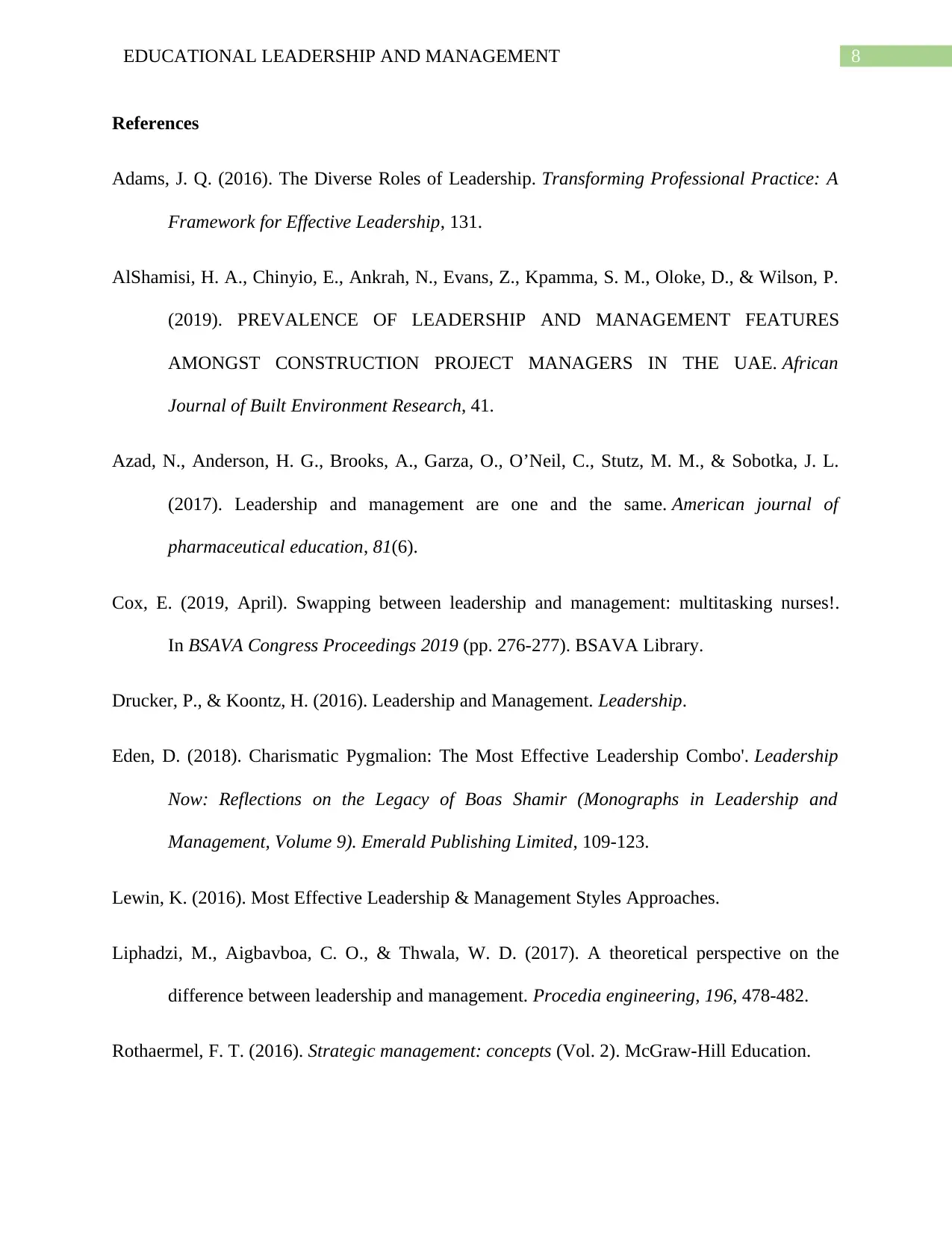
8EDUCATIONAL LEADERSHIP AND MANAGEMENT
References
Adams, J. Q. (2016). The Diverse Roles of Leadership. Transforming Professional Practice: A
Framework for Effective Leadership, 131.
AlShamisi, H. A., Chinyio, E., Ankrah, N., Evans, Z., Kpamma, S. M., Oloke, D., & Wilson, P.
(2019). PREVALENCE OF LEADERSHIP AND MANAGEMENT FEATURES
AMONGST CONSTRUCTION PROJECT MANAGERS IN THE UAE. African
Journal of Built Environment Research, 41.
Azad, N., Anderson, H. G., Brooks, A., Garza, O., O’Neil, C., Stutz, M. M., & Sobotka, J. L.
(2017). Leadership and management are one and the same. American journal of
pharmaceutical education, 81(6).
Cox, E. (2019, April). Swapping between leadership and management: multitasking nurses!.
In BSAVA Congress Proceedings 2019 (pp. 276-277). BSAVA Library.
Drucker, P., & Koontz, H. (2016). Leadership and Management. Leadership.
Eden, D. (2018). Charismatic Pygmalion: The Most Effective Leadership Combo'. Leadership
Now: Reflections on the Legacy of Boas Shamir (Monographs in Leadership and
Management, Volume 9). Emerald Publishing Limited, 109-123.
Lewin, K. (2016). Most Effective Leadership & Management Styles Approaches.
Liphadzi, M., Aigbavboa, C. O., & Thwala, W. D. (2017). A theoretical perspective on the
difference between leadership and management. Procedia engineering, 196, 478-482.
Rothaermel, F. T. (2016). Strategic management: concepts (Vol. 2). McGraw-Hill Education.
References
Adams, J. Q. (2016). The Diverse Roles of Leadership. Transforming Professional Practice: A
Framework for Effective Leadership, 131.
AlShamisi, H. A., Chinyio, E., Ankrah, N., Evans, Z., Kpamma, S. M., Oloke, D., & Wilson, P.
(2019). PREVALENCE OF LEADERSHIP AND MANAGEMENT FEATURES
AMONGST CONSTRUCTION PROJECT MANAGERS IN THE UAE. African
Journal of Built Environment Research, 41.
Azad, N., Anderson, H. G., Brooks, A., Garza, O., O’Neil, C., Stutz, M. M., & Sobotka, J. L.
(2017). Leadership and management are one and the same. American journal of
pharmaceutical education, 81(6).
Cox, E. (2019, April). Swapping between leadership and management: multitasking nurses!.
In BSAVA Congress Proceedings 2019 (pp. 276-277). BSAVA Library.
Drucker, P., & Koontz, H. (2016). Leadership and Management. Leadership.
Eden, D. (2018). Charismatic Pygmalion: The Most Effective Leadership Combo'. Leadership
Now: Reflections on the Legacy of Boas Shamir (Monographs in Leadership and
Management, Volume 9). Emerald Publishing Limited, 109-123.
Lewin, K. (2016). Most Effective Leadership & Management Styles Approaches.
Liphadzi, M., Aigbavboa, C. O., & Thwala, W. D. (2017). A theoretical perspective on the
difference between leadership and management. Procedia engineering, 196, 478-482.
Rothaermel, F. T. (2016). Strategic management: concepts (Vol. 2). McGraw-Hill Education.
⊘ This is a preview!⊘
Do you want full access?
Subscribe today to unlock all pages.

Trusted by 1+ million students worldwide
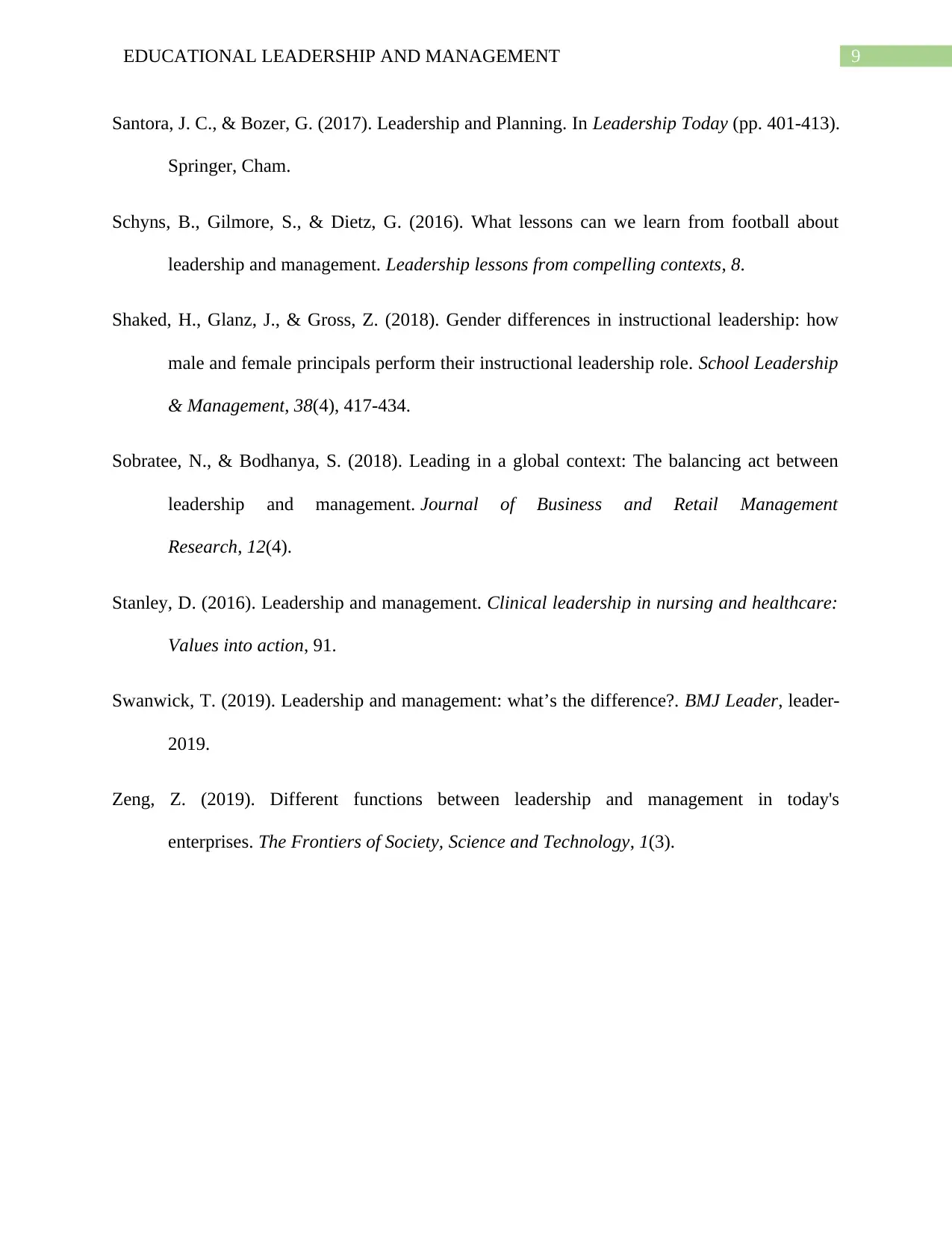
9EDUCATIONAL LEADERSHIP AND MANAGEMENT
Santora, J. C., & Bozer, G. (2017). Leadership and Planning. In Leadership Today (pp. 401-413).
Springer, Cham.
Schyns, B., Gilmore, S., & Dietz, G. (2016). What lessons can we learn from football about
leadership and management. Leadership lessons from compelling contexts, 8.
Shaked, H., Glanz, J., & Gross, Z. (2018). Gender differences in instructional leadership: how
male and female principals perform their instructional leadership role. School Leadership
& Management, 38(4), 417-434.
Sobratee, N., & Bodhanya, S. (2018). Leading in a global context: The balancing act between
leadership and management. Journal of Business and Retail Management
Research, 12(4).
Stanley, D. (2016). Leadership and management. Clinical leadership in nursing and healthcare:
Values into action, 91.
Swanwick, T. (2019). Leadership and management: what’s the difference?. BMJ Leader, leader-
2019.
Zeng, Z. (2019). Different functions between leadership and management in today's
enterprises. The Frontiers of Society, Science and Technology, 1(3).
Santora, J. C., & Bozer, G. (2017). Leadership and Planning. In Leadership Today (pp. 401-413).
Springer, Cham.
Schyns, B., Gilmore, S., & Dietz, G. (2016). What lessons can we learn from football about
leadership and management. Leadership lessons from compelling contexts, 8.
Shaked, H., Glanz, J., & Gross, Z. (2018). Gender differences in instructional leadership: how
male and female principals perform their instructional leadership role. School Leadership
& Management, 38(4), 417-434.
Sobratee, N., & Bodhanya, S. (2018). Leading in a global context: The balancing act between
leadership and management. Journal of Business and Retail Management
Research, 12(4).
Stanley, D. (2016). Leadership and management. Clinical leadership in nursing and healthcare:
Values into action, 91.
Swanwick, T. (2019). Leadership and management: what’s the difference?. BMJ Leader, leader-
2019.
Zeng, Z. (2019). Different functions between leadership and management in today's
enterprises. The Frontiers of Society, Science and Technology, 1(3).
1 out of 10
Related Documents
Your All-in-One AI-Powered Toolkit for Academic Success.
+13062052269
info@desklib.com
Available 24*7 on WhatsApp / Email
![[object Object]](/_next/static/media/star-bottom.7253800d.svg)
Unlock your academic potential
Copyright © 2020–2025 A2Z Services. All Rights Reserved. Developed and managed by ZUCOL.




